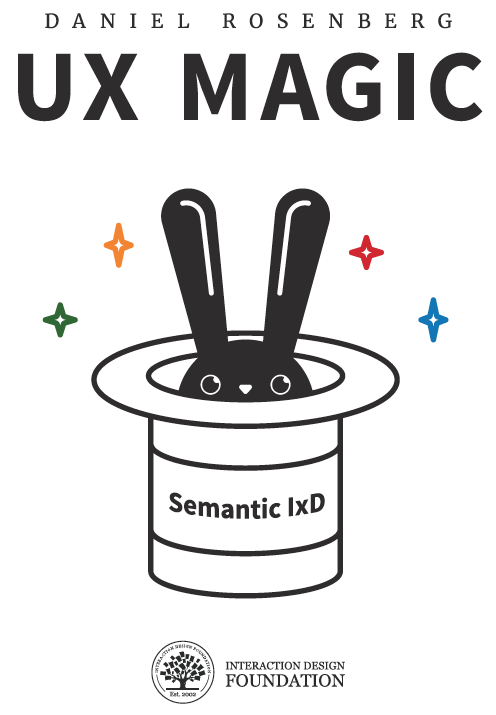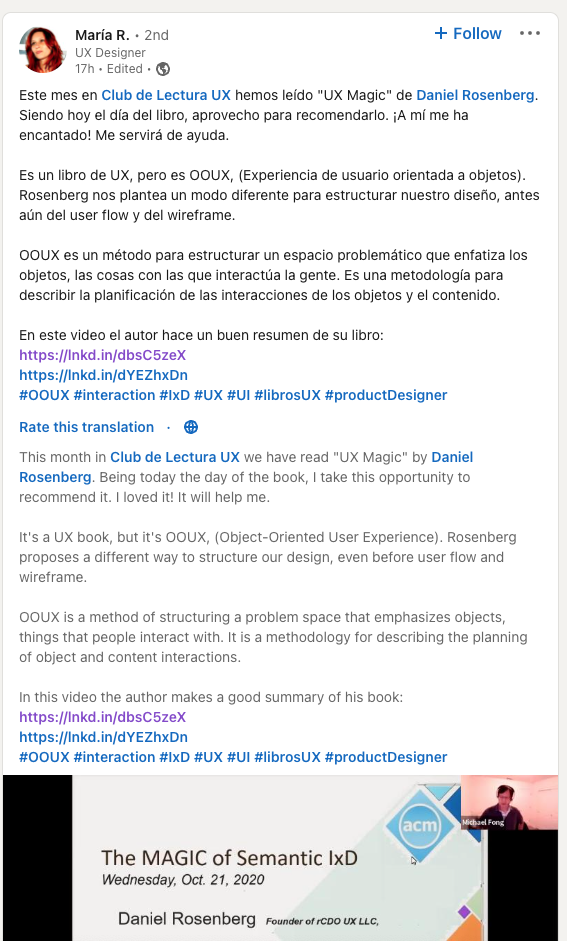UX Magic is my HCI textbook on the Semantic IxD method I both practice as consultant and teach as a professor. The book is available on Amazon in both paperback and eBook format.

Read a Medium article on The Magic of Semantic Interaction Design to get a high level overview of the book.
Watch’s Dan’s invited guest lecture on Semantic IxD at the Carnegie Mellon HCI Institute.
Corporate training and university guest lectures based on the book are available in half day, full day or multi-day increments. Please contact info@rcdoux.com for a prospectus.
Book jacket description:
UX Magic introduces a proven, powerful and comprehensive approach to User Experience Interaction Design that improves both the quality of initial UX designs as well as the speed at which they can be delivered by a factor of 10X. It is grounded in decades of cognitive science research and has been refined through practical application as documented in the dozens of real product design examples it includes. This new approach addresses the weakest link in the user centered design lifecycle, the point where features and user requirements metamorphize into UX sketches, flows and other tangible design artifacts. UX Magic substitutes a scalable, repeatable cognitive design method in place of guess work, intuition and endless rounds of A/B trial and error testing.
Minimizing users cognitive load is the holy grail of HCI. It is possible to calculate the cognitive load of UX design alternatives before you sketch the first screen. Cognitive load can be measured in a usability lab with a prototype or an early software release but by then it is both late and expensive to fix. In addition, lab measurements don’t isolate the root cause of the complexity. They only tell you that you failed.
The UX Magic method extends the prior “designers’ conceptual model” approach beyond the its foundation as the semantic definition of the objects and actions to be exposed to the user. This extension lifts the conceptual model approach into the selection of optimal GUI design patterns and then into the specification of user flows. At its pinnacle it steps into the realm of applied game theory for IxD. At all these levels the method focuses on minimizing the cognitive load placed on the user in order to generate the simplest and most elegant UX possible.
UX Magic also demonstrates how the use of proven visual design principles apply on screen to create the consistent affordances necessary to successfully communicate the designers conceptual model intent. It further considers how all of these different design layers and elements interact with UI style guides and standards, including guidance on when to follow and when to ignore them. UX Magic is a deep dive into the most effective way to practice IxD during the critical product stages of synthesis, ideation and design execution. It is dedicated to the goal of empowering both experienced UX practitioners and aspiring students to level up and create outstanding experiences that deliver maximum value to both product users and the organizations that create them.
The book has received many positive reviews (see examples below) on its practical approach in concert with providing a complete systems level approach to understand interaction design.

Also check out Francisco Diazluna’s reference to the value of the Semantic IxD method (and UX MAGIC book recommendation) in his article on the 4 pillars of success in the tech industry inside this Forbes Innovation Magazine article he wrote. https://hubs.li/Q01W3KHd0

